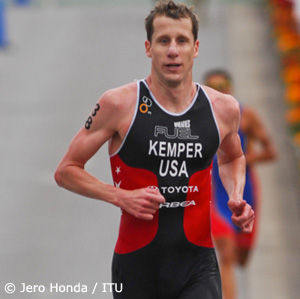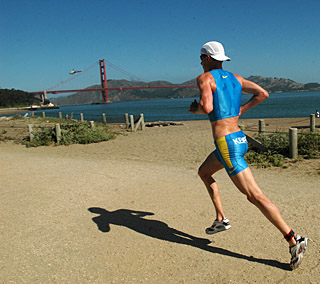Hunter Kemper is back

In a blazing 2005 season, he won the ITU World Cup men’s season points crown, took two World Cup victories and an Escape From Alcatraz crown and made the cover of a Wheaties Box. In 2006, he followed up with a $200,000 win at Life Time Fitness and was a top contender to take an Olympic medal in 2008.
Since then Hunter Kemper showed what he was truly made of.
In the Beijing Olympic qualifying process, Kemper was stricken with a near-crippling sacroiliac joint injury that left him hurting badly, edged out of the first two American slots, and hanging by a thread with one race remaining for the third American men’s triathlon ticket to Beijing. With the help of some pain-killing cortisone shots and a lot of grit, Kemper made the squad at Hy-Vee and then overcame more lingering injuries to finish 7th — his best Olympic finish in three tries.
After an extensive recovery process after the Games, Kemper finished 5th at the Washington DC World Championship Series event in 2009. But after lingering physical woes plagued him the rest of that season, he seemed to be back on his usual world-class level after a win at the 2010 edition of Escape From Alcatraz. Whereupon he spent the rest of the season laid up with more injuries.
As 2011 began, the 34-year-old American Olympic distance triathlon star had to wonder if his racing odometer had run its course. But after an inspiring win at the Ishigaki World Cup a week ago, he was back on course for a run at a 4th Olympic appearance.
This time around, Kemper is 34 years old and approaching his lifelong quest for Olympic glory with a new coach, new patience and a new layer of caution born of his struggles with injury.
Slowtwitch: After losing much of last year to injuries, your first race of 2011 didn’t go so well. Some people thought you might have lost your edge.
Hunter Kemper: I got a slow start at Sydney. I needed a bit more time to adapt to the time change. In the past I’ve been able to come in on Thursday or Friday for a weekend race. But I just felt awful warming up for the race and 31st place was no surprise. Afterwards I took a look at the results in Sydney and most of the top guys and women had been in Australia for weeks in advance and doing their final training there.
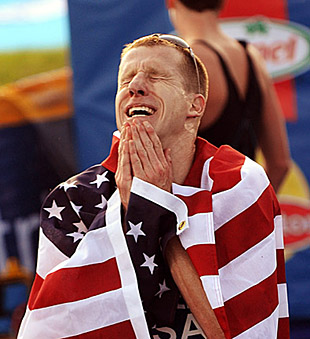
ST: Will you change your habits and arrive a little sooner?
Hunter: In the future, if I want to give myself the best chance with the long trips and time zone changes — I will have to go in early. As things turned out, it might have been a better idea to go to Australia and race Mooloolaba two weeks earlier. Going forward, it will take a time commitment and I have family which is why I have preferred to go on Thursday before a race. I have done it before and had success. But I see it can be hit or miss after getting the short end of the stick on my first important race this year.
ST: How would you evaluate your performance in that first race at Sydney?
Hunter: I tried to do what I could and get away on the bike. Unfortunately it was rainy and there were a lot of wrecks. Javier Gomez — what a performance! — he went down got back up and won.
ST: Why did you have such a dramatic turnaround at Ishigaki?
Hunter: I knew that the Ishigaki field was not as big, not as deep as Sydney. I also knew I’d been in country one week. The big trip was from Colorado Springs to Taiwan, a 9 hr flight, and then to Sydney. Japan was only a short trip and a one hour time zone difference. It was like going from Colorado to Texas. So I knew my body would come around and produce a good result.
ST: You ran into several injuries last year after a big comeback win at Escape From Alcatraz. What happened right after that big win?
Hunter: After Escape I was getting ready for Hy-Vee and got a stress fracture in the pelvis area during a run workout on a treadmill at the Olympic Training Center.
ST: The same area as your sacroiliac joint issues which plagued you before the Beijing Olympics?
Hunter: It was the same area as the sacroiliac joint — but it was a different injury. With a stress fracture there is nothing you can do but rest and let it heal. It’s not like you can stop running and keep fitness with biking. It hurt just sitting on the bike. So I was on crutches a few weeks, just able to walk around. It happened in early June and I essentially did no training over the summer months.
ST: What was the purpose of that workout?
Hunter: I was in the middle of six one-mile repeats – two at 4:30 per mile, two at 4:25 and two at 4:20 with 1 minute rest intervals. I was running with supplemental oxygen, which makes it possible to try to go at a faster clip than you can go at altitude. On the fourth mile I felt a great deal of pain in my upper hamstring and I had to stop. I thought I’d pulled a muscle but I did not realize it was a stress fracture in the pelvic area.
ST: Was there anything about running on a treadmill that put more stress than simply running those fast miles outdoors or on a track?
Hunter: I believe there was more strain on the treadmill because I would jump on and off the treadmill when it was at full speed. The next time I try that workout I will have the treadmill start at rest and work my way up to top speed before the timed miles. And when each mile is over, have the treadmill back off gradually.
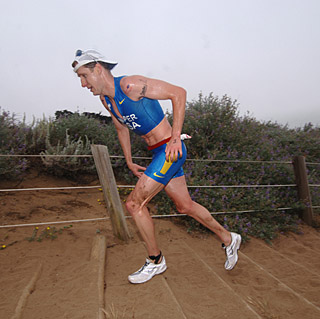
ST: Sounds like you were ambitious leading up to Hy-Vee. Presumably you were more cautious going into your next race four months later?
Hunter: Once I recovered from the stress fracture, training went well and my first race back was in Dallas in early October. I led out of the water and was second on the bike until mile 12 when I took a left hand turn too fast. After that I cannot remember what happened. I just know I blacked out and I have amnesia about the actual fall. I think my wheels slid out and I went straight down and woke up in the ambulance and my whole left side felt like it was on fire. I had a broken collarbone in four places and I also cracked a couple ribs. I had collarbone surgery 10 days later where doctors inserted a plate in there and screws. With the ribs, there is really nothing you can do about it. They don’t take a splint. You’ve just got to let it heal.
ST: How is it now? When did you recover enough to train again?
Hunter: It’s all better now. It was a tough year. Escape was such a high and after that my training was going well. The rest of the year was a tough go for me with all the injuries. So far this year I am healthy and have no injuries. No illness and I feel really good.
ST: So how would you evaluate this year and your long term goals?
Hunter: The first race was disappointing and the second race was promising. The way the sport has gone, with some courses, if you do not run really fast you are not going to win a big race. So for me to have the fastest run of the day at Ishigaki [31:12] was a great confidence builder. I felt good the whole run, never really pushed the last lap or two and I did not have to extend myself – which is good. I can learn from this run and race and build on my fitness. Right now I am not near where I need to be to qualify for the London Olympics. My big race this year will be the London World Championship Series race on August 6, which serves as the first US Men’s Triathlon Olympic Trials qualifier.
ST: What will you be aiming at in the London World Championship Series event in 2011?
Hunter: In London, the top American that that crosses the line and finishes in the top 9 will get the first automatic Olympic slot.
ST: Why not top 8 or top 10 as many countries have it?
Hunter: Maybe they split the difference. If the top American finishes 9th or better he [or she] gets an automatic spot to the Olympics. However, if there are two Americans in the top 9, they both won’t go. If two Americans finish in the top 5, then both Americans can go.
ST: A double qualification at London for the US men seems highly unlikely with the Brownlees, Gomez and many more top contenders all primed for the last shootout on the Olympic course?
Hunter: That is unlikely for the men. But on the women’s side, Sarah Haskins and Laura Bennett potentially could make it in London. That of course would be very challenging.
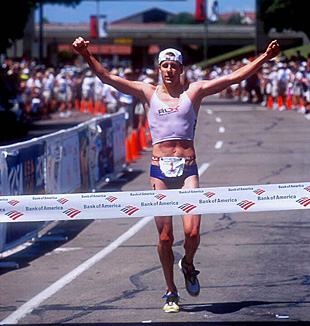
ST: During your injuries, did you have any doubts that your career could continue at a high level?
Hunter: In the midst of last year, yeah. I think I had quite a few doubts whether I could get back. It has been a long journey with many low spots. But whenever I was injured the last few years I have always had enough highs to get me through. In 2008, I recovered from my first sacroiliac injuries to take the final Olympic spot at Hy-Vee. Then I recovered again just in time to finish 7th at the Olympic race in Beijing. And the win at Alcatraz last year was huge. The field was great – Bevan Docherty was just off a Sydney World Championship Series win. Andy Potts, who has won that racer three times, was there and I beat him by a large margin. I felt really good that day. It gave me a great deal of confidence that when I was healthy and able to train better than I had in a long time, I could win a big race. I was feeling up for Hy-Vee. But two weeks before the race I got that stress fracture on the treadmill. And later, I broke my collarbone at Dallas. So until I got healthy, started training well again and won Ishigaki, there were questions.
ST: Why did you switch from George Dallam to Cliff English last year?
Hunter: I was with George Dallam my entire career since 1997 and he has been an essential factor in my success. But I had come to a point which had nothing to do with George. We did not have a falling out. He is a great person, a great coach and he had been totally supportive our entire time together. It was just that I felt everybody needs to shake things up every now and then. I felt I wanted to try a different stimulus to create different gains. I think you get stale when you do the same thing all the time. …
ST: Why did you choose to work with Cliff English?
Hunter: I knew Cliff and we worked together at the Olympic Training Center when he was the high performance director at USAT. His coaching philosophy is in many ways very similar to George’s. It wasn't as if I was taking a 180-degree turn completely away from the way I used to train. Cliff’s approach fits in with what I believe works for me.
ST: What are their similarities?
Hunter: The main thing is they both have take a lot of input from the athlete. They are not the type of coaches who say they know it all. They want to use input from the athlete and they are not at all dictatorial.
ST: What is it like working with Cliff?
Hunter: Cliff has a willingness to work with athletes – he is humble and does not say he knows it all and it’s my way or the highway. I give input and he might say OK, we can incorporate it, or modify it a bit. He has the ability to have give and take and listen to and understand the athlete.
ST: What are his unique strengths?
Hunter: He has great knowledge of ITU style racing and he knows what it takes to get to the podium at a big race. He is very good on-site with the little things and he is good in the lead up to the race regarding tactics and strategy. And he knows what to say to help you out in the middle of a race.
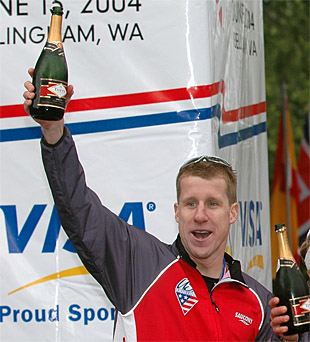
ST: Given your disappointing showing at Sydney, do you have different travel plans for key WCS races this year?
Hunter: I learned from Sydney and I plan to race the Madrid WCS in early June on a different pre-race schedule. I plan to arrive Monday for a Sunday race. In the past I tended to arrive Thursday or Friday and race Sunday. I will evaluate how it goes and, if I think it is necessary, I might arrive 10 days to two weeks ahead of time for London this year. With that comes a sacrifice with regards to my family. But that is all part of the game for this Olympic campaign.
ST: In what other ways will you be more cautious, more conservative?
Hunter: I was used to running 6 or 7 times a week up to 70 miles a week, 10 miles a day type of thing. Now I only run four times a week. I have been limited by the fact that I have been injured a lot recently. Before I had injured I had devoted a lot of my training to building a big run base.
ST: Why not slowly ease into the season ready to roll at full speed later?
Hunter: My swim and bike are good now, but my run is not where I want it. Even though at Ishigaki my run was the best [31:12] it still needs to be 40 seconds to a minute faster. In order to compete at top ITU events these days, you have to be able to run an open 10k in the low 29 minutes.
ST: Have you been at that level before?
Hunter: I have run workouts at that level. Before the injuries I could have gone on the track and run 29 mid to 29 low [minutes for a 10k]. I am not there now. Now I am in the 30 range. I have some of the strength but not the quickness, not the speed. But I believe my training will pay off when I peak in August.
ST: How tough is it to break your old habits and have the patience that you still have the firepower and will peak at the right time?
Hunter: It’s been hard to run four times a week. The reason is to get myself through the whole year. That's why I am being cautious. I have been hurt off and on the past few years. In the recent past, my workload in ’07 was five races, in ’08 it was four, in ’09 it was three and in 2010 it was two. This year I have already done two races, I am healthy and my goal this year is to race 10 times. I want to keep training and racing and moving forward all the way through August. It is hard to hold back and trust my form will be there when I need it. My form was obviously good enough to win Ishigaki. It’s not a WCS win. But it’s a good win. American men have not had a WCS win since Jarrod Shoemaker won Hamburg in 2009. It was good for me because I have not won an ITU World Cup since 2005 at Beijing.

ST: What would making your fourth Olympic team mean to you?
Hunter: My first goal is to make my fourth Olympic team. That would be huge. I think going to the Olympics any time is extraordinary but making four Olympics is an elite club. In the sport of triathlon, two girls have chance – Kiyomi Niwata of Japan and Anja Dittmer of Germany. Five guys have that chance – myself, Tim Don, Simon Whitfield, Ivan Rana and Reto Hug. With al this sport entails, it is easy to miss out one year. You have to be young to start with, you have to have a bit of luck, you must be very talented, and stay injury free during those times when you qualify. I was talking to a writer about this and I said that it would be easier to make four Olympic teams in a technical sport like shooting, where that sort of longevity would be a little easier than in a sport requiring endurance and speed. You can be competing at the age of 45 in shooting or equestrian. But there are a finite number of years in triathlon, where you must be healthy and in top form throughout the Olympic qualifying process. I do not think you will ever see a five-time Olympian in the sport of triathlon.
ST: And is winning an Olympic medal on your fourth try still possible?
Hunter: I’m not going to sit there and be happy to simply make the team. My whole journey along this whole process has been to win an Olympic medal. I always wanted to be like Matt Biondi – I want to go up there and bring home some hardware, For whatever reason I have not been up there — but I still believe. I have finished 17th, 9th and 7th and the trend keeps getting closer. I think ultimately when it comes to the Olympic Trials, I will have worked hard on my 10k speed and I can tell myself I have done enough work over enough time that I will be within 10 seconds or equal to the best in the world on the run. And I will know I can compete, that I have a chance. I will not blow the doors off people, but I can grind it out and run them off my shoulder.
ST: Top level ITU elite runs are faster than ever.
Hunter: Those guys are talented. Don’t get me wrong. The Brownlees and Gomez have advanced the sport. They are running great. It is amazing how quick the sport is now. And everyone has to change with it. I hate to think I might be going to the Games and feel that my only chance is to get away on the bike and feel it is my only option. It is not a good feeling to have in your mind that your run is not good enough.
ST: Of course, it’s not only sheer run speed. It’s staying healthy while pushing your limits.
Hunter: You have to know you have the talent and the ability to do it on the run, and that you can get strong and stay healthy while you push your boundaries. Last year I did some workouts too fast, too far, too soon and boom – I broke my pelvis. As an athlete you think you have to have to get lighter, eat less fat, and it might not work and you might end up breaking down. You have to be able to get there with all your strength and speed and will intact.


